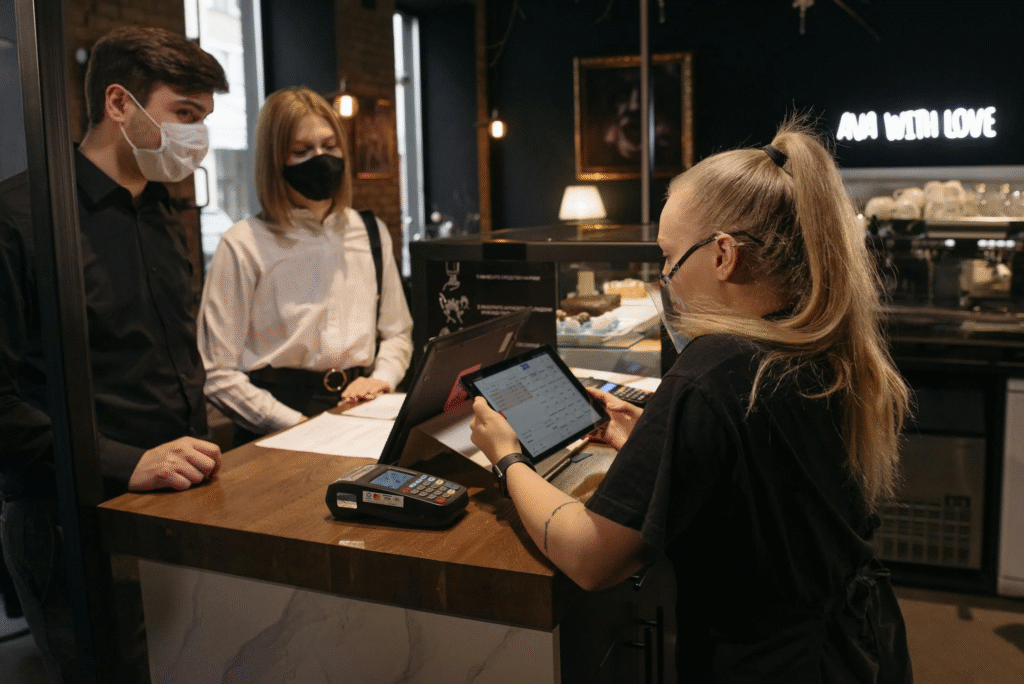
Losing customers hurts your bottom line–period. Maybe they had one bad experience. Maybe they just forgot about you. Either way, every lost customer is lost revenue. The truth is, even great restaurants lose touch with guests. What if one-off diners don’t have to be a one-time thing? Compared to other industries in 2025, restaurants have a customer retention rate of just 55%.
If you’re noticing the same thing, it means customers aren’t engaging with your restaurant long term. Decreasing engagement → lost customers. But it’s also likely that you’re not engaging with customers enough. Maybe you’re not giving enough reasons for customers to stick around. If that’s the case, it’s not too late to win them back!
In this article, we’ll cover the strategies to re-engage lost customers for restaurants.
What is Customer Churn, and Why Do Customers Drop Off?
Customer churn is the rate at which customers stop purchasing from your restaurant. But what makes customers stop purchasing in the first place? There are a couple of possible reasons to look out for:
- Dissatisfaction with your product or service
Maybe your food isn’t hitting like it used to. Maybe your customer service leaves more to be desired. Whatever it is, sometimes it’s useful to review your staff and menu, and gather feedback on what needs improvement.
- Competitive prices
With new restaurants opening at every other corner, it’s no wonder that customers are finding it harder to stick with one place. Menu prices have climbed 4.1% in 14 months. Customers want the best deal, and they’ll switch restaurants to get it. It might be worth it to check how well your menu’s value matches its price.
- Lack of post-purchase support or incentives
So a customer dines at your restaurant, they have a good time, no complaints, but what comes after? If you don’t engage, some other restaurant will grab their attention. Having a customer purchase at your restaurant isn’t enough anymore; you need to give them incentives to come back.
Types of Re-Engagement Campaigns For Restaurants
1. Customer appreciation
For lost new customers, or customers who don’t plan to dine at your restaurant for a second time, what you want is to give attention to them, value their purchase, and prevent them from ghosting.
2. Customer reactivation
For lost loyal customers, or customers who were once regulars at your restaurant but have drifted away, what you need is to rekindle that relationship, either by reminding them of their favorite menus, or offering new deals they’ve missed out on.
How to Win Back Lost Customers For Restaurants
1. Segment customers
Goal: Segmenting customers means that you can determine which re-engagement campaign is for customer appreciation or reactivation.
The first step to winning back lost restaurant customers is to identify which ones have the most impact on your restaurant’s profit. Prioritize high spenders and at-risk customers. Make sure those alarmingly close to inactivity still have one foot in the door.
You can also segment customers based on their reasons for churn. For example, customers who stop coming by because of poor customer service can have a different re-engagement strategy than those complaining about menu quality.
Another trick is to group customers by their length of inactivity. Set a timeframe for who you’d consider to be an active customer. Once they’ve fallen outside of the timeframe, you can devise different strategies to win them back. The customers who’ve been inactive for 3 months can get a softer campaign than the ones who’ve been quiet for a year.
2. Use behavior data to design a working win-back strategy
Goal: Behavior data is most useful for customer reactivation, because you’ll have more data at your disposal from lost loyal customers rather than one-time diners.
The best move to win back lost customers is to understand who they are. And if they’ve signed up to your loyalty program, then they’ve already handed you the key to their treasure trove of purchasing behaviors. Once you have customers’ transaction history and personal preferences, you’re one step closer to winning them over.
For example, if you have data about the last or most frequent order of lost customers, you can analyze patterns from similar cases and tailor an irresistible strategy to ensure re-engagement. Tell customers you know what they like or don’t like, and you’re able to provide them with what they need!
3. Reward customer loyalty with special win-back offers
Goal: Rewarding customers is best suited for customers’ first couple of purchases (appreciation) and for customers who have stopped purchasing for a while (reactivation).
So, a customer has moved on to other restaurants. How do you make them miss you? Cue the loyalty program. This can be as costly, complex, or as simple as you want it to be. Loyalty programs are scalable, customizable, and true to their name; they attract loyalty.
44% of Gen Z diners look for deals and coupons on social media. You can offer lost customers special discounts or freebies so good they won’t be able to resist coming back. How to get old customers back? The answer is using a loyalty program for personalized offers they can’t refuse!
4. Share something new
Goal: New menus are most effective for customer reactivation. Lost loyal customers are more likely to be interested in fresh ideas than newcomers who still haven’t tried most of your regular menu.
Nothing catches the eye quite like the word “NEW!” The next best thing is probably the word “LIMITED.” With that in mind, combining the two can leave a strong impression on lost customers. It tells them to pay attention.
For example, you can market an updated menu to keep your restaurant exciting and fresh or revive a seasonal menu that’s only available for a limited time. These will attract old visitors and remind them of an existing connection with your brand. Finally, don’t forget to include those magic words!
Case Study:
SimpleLoyalty once held a campaign for a Kopitiam in Kuala Lumpur that leveraged its limited time. The plan was to have a Buy 1 Get 1 Free promo only from 10 PM to midnight. This brought in both old and new customers who wouldn’t typically dine during regular hours. In the end, the restaurant discovered that there’s value in keeping the restaurant’s opening hours late, but not as late as midnight. And the campaign’s peak earnings were at 10 PM, reaching around RM 521 daily.
5. Utilize omnichannel communication
Goal: Omnichannel communication is helpful for both customer appreciation and reactivation, depending on what message you choose to convey.
Imagine there’s a lost customer who’s changed their email since they last subscribed to your restaurant. If your marketing channel only relies on email communication, then that customer can be lost for good. But if you use omnichannel communication, you can have a wider outreach that makes sure your messages reach the right customers.
The methods that can be used include email, social media, SMS, and targeted ads. However, be careful not to spread yourself too thin. An omnichannel approach is only effective if the message quality is as good as the quantity of channels.
Case Study:
One example from SimpleLoyalty is when a hot pot in Kuala Lumpur faced challenges on Tuesdays, with the lowest customer visits. The solution was to promote a double loyalty point multiplier on off-peak days through SMS and social media. The campaign brought in an additional RM 103,740 annually, with a 7% increase in customer visits on Tuesdays.
6. Track the reason for churn
Goal: Digging into the reasons for disengagement is where you’ll discover which lost customers require appreciation or reactivation.
Behind every lost customer is a reason they back out. If you can find out why, you can get to how you’ll win them back.
By analyzing customer data, you can figure out if customers gradually reduce purchases or instantly drop off after a certain order. Going even further, if you know when customers stop purchasing at your restaurant, you can compare it with the time a new competitor is on the market, or when there’s a change in staff. This will help you pinpoint just what made your customers stop buying from you, and this information is the backbone of a working win-back strategy.
7. Get the timing right
Goal: Timing is useful for both customer appreciation and reactivation. The difference is that for lost new customers, your campaign should start sooner, while your restaurant is still on their mind, compared to customers who haven’t visited for months.
3.13 million emails are sent every second. How can you make sure that your campaign is seen by lost customers? Well, there’s a tried and true strategy called a drip campaign. The general guideline is to space out re-engagement messages 4 days to 2 weeks apart, preferably running for up to 3 months.
It’s good to know when to re-engage and when to stop. You can start reaching out to lost customers after 30-60 days of inactivity, or even do another go around after 3-6 months. And this doesn’t have to be only email. You can use SMS as well. To find out which channel and timing works best, A/B testing is your best friend.
Takeaway
Losing customers is always a bummer. It hurts your revenue and your restaurant in general. It can be your fault or your customers’ situations, but there’s no use dwelling on it when you can take action! You can win lost customers back by utilizing these re-engagement strategies:
- Segment customers
- Use behavior data to design a working win-back strategy
- Reward customer loyalty with special win-back offers
- Share something new
- Utilize omnichannel communication
- Track the reason for churn
- Get the timing right
What’s with the wait? Try out SimpleLoyalty for FREE, and we can help you get right to re-engaging lost customers! You’ll see just how important lost customers are when you feel a boost in profit once they return.

